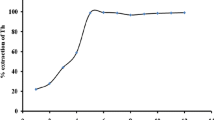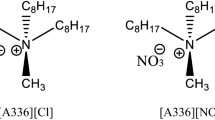Abstract
Neutral complexes of thorium and lanthanides with 2,3-dihydroxynaphthalene and anionic complexes of uranium with the same chelating agent in presence of cetyltri-methylammonium ion are extracted into ethylacetate at the pH 5–6, 9–10 and 10–12 respectively. All these elements are then quantitatively stripped off into dilute acid solutions and then determined by ICP-OES. Certified Reference Materials like SY-2, SY-3, GSP-2 and a statistical paired ‘t’ test are conducted for validation of the method. The results obtained for a set of rock and grab samples are compared with other standard techniques yielding high degree of accuracy and precision.

Similar content being viewed by others
References
Gupta CK, Krishnamurthy K (1992) Extractive metallurgy of rare earths. Int Mater Rev 37(5):197–248
Balram V (2019) Rare earth elements: a review of applications, occurrence, exploration, analysis, recycling, and environmental impact. Geosci Front 10:1285–1303
Chakrapani G, Krishnakumar M, Hanuman VV (2017) A handbook on chemical characterization of atomic minerals. A Publication of Chemistry Group, AMD/DAE, Govt. of India, Hyderabad
Henderson P (1984) Rare earth elements geochemistry. Elsevier, New York
Sengupta JG (1984) Determination of scandium, yttrium and lanthanides in silicate rocks and four new Canadian iron formation reference materials by flame atomic absorption spectrometry with micro sample injection. Talanta 31(12):1045–1051
Sengupta JG (1981) Determination of yttrium and rare earth elements in rocks by graphite-furnace atomic absorption spectrometry. Talanta 28(1):31–36
Pal S, Terrell DJ (1978) Instrumental neutron activation analysis of twenty nine international geochemical reference samples. Geostand Newslett 2(2):187–197
Radhamani R, Murugesan P, Srivastava PK (2007) Rapid decomposition of monazite and xenotime for determination of Th and REE by inductively coupled plasma emission spectrometry. Explor Res At Miner 17:174–179
Roelandts I, Michel G (1986) Sequential inductively coupled plasma determination of some rare earth elements in five French geo-standards. Geostand Newslett 10(2):135–154
Satyanarayana K, Srinivasan G, Malhotra RK, Tikkoo BN (1989) Determination of rare earth elements and yttrium in some uranium and thorium rich geological materials by inductively coupled plasma emission spectrometry. Explor Res At Miner 2:235–245
Premadas A (2012) Determination of trace level lanthanides and thorium by inductively coupled plasma atomic emission spectrometry in different types of geological, red mud, and coal fly ash samples after separation as oxalates using calcium as carrier. Atom Spectrosc 33(1):14–23
Satyanarayana K, Nayeem MA (2002) Application of solvent extraction and acid hydrolysis of Nb/Ta separation methods for the determination of uranium in geological materials, Nb/Ta-type samples and leach liquors by ICP-OES. Atom Spectrosc 23(3):77–85
Djingova R, Ivanova Ju (2002) Determination of rare earth elements in soils and sediments by inductively coupled plasma atomic emission spectrometry after cation exchange separation. Talanta 57(5):821–829
Raju CSK, Subramanian MS (2007) Sequential separation of lanthanides, thorium and uranium using novel solid phase extraction method from high acidic nuclear wastes. J Hazard Mater 145:315–322
Murthy DSR, Chakrapani G (1996) Pre-concentration of rare earth elements on activated carbon and its application to groundwater and sea-water analysis. J Anal At Spectrom 11:815–820
Vijay K, Sanjay K, Naveen K, Bangroo PN (2013) Separation and pre-concentration of rare earth elements in geological materials using used green tea leaves and their determination by ICP-OES. J Indian Chem Soc 90(11):2147–2151
Nakamura T, Nishihama S, Yoshizuka K (2007) Separation and recovery process for rare earth metals from fluorescence material wastes using solvent extraction. Solv Extr Res Dev 14:105–113
Srivastava PK, Premadas A (1999) Determination of rare earth elements and yttrium in rocks by inductively coupled plasma atomic emission spectrometry after solvent extraction with a mixture of 2-ethylhexyldihydrogenphosphate and bis(2-ethylhexyl) hydrogen phosphate. J Anal At Spectrom 14:1087–1091
Kraikaew J, Srinuttrakul W, Chayavadhanakur C (2005) Solvent extraction study of rare earths from nitrate medium by the mixtures of TBP and D2EHPA in kerosene. J Met Mater Miner 15(2):89–95
Jedinakova V, Vanura P, Zilkova J, Bilek V, Touati F (1992) Extraction of micro and macro concentration of rare earth ions with the mixture of D2EHPA and TBP in n-hexane and cyclohexane. J Radioanal Nucl Chem 162(2):267–276
Xie F, Zhang TA, Dreisinger D, Doyle F (2014) A critical review on solvent extraction of rare earths from aqueous solutions. Miner Eng 56:10–28
Tochiyama O, Freiser H (1981) Mixed ligand chelate extraction of lanthanides with 1-phenyl-3-methyl-4-octanoyl-5-pyrazolone systems. Anal Chem Acta 131:233–238
Haraguchi K, Yamazaki Y, Saitoh T, Kamidate T, Watanabe H (1990) Solvent extraction of lanthanides (III) with N-alkyl carbonyl-substituted N-phenyl hydroxylamines. Anal Sci 6:877–883
Noro J, Sekine T (1993) Effect of a solvent on the extraction of the Europium (III) 2-thenoyltrifluoroacetonate anionic complex as ion-pairs with tetra-butyl ammonium ions. Bull Chem Soc Jpn 66:450–454
Tarafder PK, Murugan P, Kunkal L, Rathore DPS (2002) Extraction of uranium with 2,3 dihydroxynaphthalene and cetyltrimethylammoniumbromide, and its fluorimetric determination in silicate rocks. J Radioanal Nucl Chem 253:135–142
Pradhan SK, Ambade B, Tarafder PK (2020) An evolved fluorimetric determination of uranium in rock/mineral sample solutions containing hydrolysable elements such as Nb, Ta, Zr and Ti sequestered by bi-fluoride. Appl Radiat Isot 160:109126
Pradhan SK, Ambade B (2020) Separation and pre-concentration of trace uranium (VI) by solid phase extraction with 2,3-dihydroxynaphthalene and cetyl tri-methyl ammonium bromide on molten naphthalene and its LED fluorimetric determination in water samples. Anal Sci 36(2):207–212
Tarafder PK, Pradhan SK, Mondal RK (2016) Separation of thorium by facile liquid-liquid extraction, and its rapid spectrophotometric and ICP-AES determination in rocks and minerals. J Radioanal Nucl Chem 309:1021–1028
Tarafder PK, Pradhan SK, Roychowdhury S (2018) An extractive pellet fluorimetric determination of trace uranium in thorium rich samples. J Radioanal Nucl Chem 316(2):527–534
Pradhan SK, Ambade B (2020) Extractive separation of rare earth elements and their determination by inductively coupled plasma optical emission spectrometry in geological samples. J Anal At Spectrom 35(7):1395–1404
Tarafder PK, Pradhan SK, Mondal RK, Sircar JK (2013) Liquid-liquid extraction of rare earth elements (total) using 2,3-dihydroxynaphthalene as an extractant and its application to the determination of REEs (total) in silicate rock, soil and sediments samples. J Indian Chem Soc 90(11):1961–1967
Thakur R, Pradhan SK, Jha RR, Tarafder PK (2013) Liquid-liquid extraction of molybdenum and its ultra-trace determination by graphite furnace atomic absorption spectrometry. Explor Res At Miner 23:117–123
Tarafder PK, Pradhan SK (2007) Ultra-trace determination of manganese by direct and extractive-furnace atomic absorption spectrometry (GF-AAS). Explor Res At Miner 17:225–230
Tarafder PK, Mondal RK (2012) Micelle mediated extraction of iron and its determination in geological, geochemical, hydro-geochemical, bio-geochemical and process solutions. Am J Anal Chem 3:339–346
Pradhan SK, Ambade B (2019) A modified method for the determination of uranium in Nb/Ta minerals by LED fluorimetry. J Radioanal Nucl Chem 320(2):459–466
Pradhan SK, Ambade B (2021) Determination of trace uranium in thorium matrix by laser induced fluorimetry after separation of thorium by its fluoride precipitation using NH4HF2. Radiochim Acta 109(3):195–203
Pradhan SK, Tarafder PK (2013) Determination of Al in water samples by graphite furnace atomic absorption spectrometry after pre-concentration involving co-precipitation with Fe and separation by liquid-liquid extraction. Explor Res At Miner 23:125–130
Jeffery GH, Basset J, Mendhan J, Denney RC (1989) Vogel’s textbook of quantitative chemical analysis, 5th edn. ELBS, Longman Group
Acknowledgements
The authors are thankful to Dr. P. K. Tarafder, Ex-incharge, Chemistry Laboratory, AMD, Jamshedpur for his constant encouragement, support and motivation to do the work. Sincere thanks and gratitude to Directors, NIT, Jamshedpur and AMD, Hyderabad for their kind permission to do research work leading to a Ph.D. (SKP). The authors are also thankful to Additional Directors (OP-I and R&D), AMD, Hyderabad, Regional Director and Dy. Regional Director, AMD, Eastern Region, Jamshedpur and Head, Chemistry Group, AMD, Hyderabad for providing necessary facilities to carry out the work. Thanks are due to Dr. Vijay Kumar, Ex-incharge, Chemistry Laboratory, AMD, Jamshedpur for his guidance to ICP-OES measurements from time to time. Special thanks to Dr. S. Shaktivel, Assistant Professor, NIT, Jamshedpur for his guidance to draw the different reaction schemes.
Funding
This research did not receive any specific grant from funding agencies in the public, commercial, or not-for-profit sectors.
Author information
Authors and Affiliations
Corresponding author
Ethics declarations
Conflict of interest
The authors declare that they have no conflict to interest.
Additional information
Publisher’s Note
Springer Nature remains neutral with regard to jurisdictional claims in published maps and institutional affiliations.
Rights and permissions
About this article
Cite this article
Pradhan, S.K., Ambade, B. A scheme for sequential separation of thorium, lanthanides, uranium in geo-materials and their ICP-OES determination. J Radioanal Nucl Chem 329, 115–125 (2021). https://doi.org/10.1007/s10967-021-07785-x
Received:
Accepted:
Published:
Issue Date:
DOI: https://doi.org/10.1007/s10967-021-07785-x




